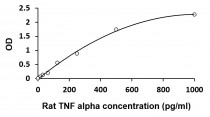ARG82319
Rat TNF alpha ELISA Kit
Rat TNF alpha ELISA Kit for ELISA and Rat
Component
| Cat No | Component Name | Package | Temp |
|---|---|---|---|
| ARG82319-001 | Antibody-coated microplate | 8 X 12 strips | 4°C. Unused strips should be sealed tightly in the air-tight pouch. |
| ARG82319-002 | Standard | 2 X 10 ng/vial | 4°C |
| ARG82319-003 | Standard/Sample diluent | 30 ml (Ready to use) | 4°C |
| ARG82319-004 | Antibody conjugate concentrate (100X) | 1 vial (100 µl) | 4°C |
| ARG82319-005 | Antibody diluent buffer | 12 ml (Ready to use) | 4°C |
| ARG82319-006 | HRP-Streptavidin concentrate (100X) | 1 vial (100 µl) | 4°C |
| ARG82319-007 | HRP-Streptavidin diluent buffer | 12 ml (Ready to use) | 4°C |
| ARG82319-008 | 25X Wash buffer | 20 ml | 4°C |
| ARG82319-009 | TMB substrate | 10 ml (Ready to use) | 4°C (Protect from light) |
| ARG82319-010 | STOP solution | 10 ml (Ready to use) | 4°C |
| ARG82319-011 | Plate sealer | 4 strips | Room temperature |
Overview
| Product Description | ARG82319 Rat TNF alpha ELISA Kit is an Enzyme Immunoassay kit for the quantification of Rat TNF alpha in serum, plasma (heparin, EDTA) and cell culture supernatants. |
|---|---|
| Tested Reactivity | Rat |
| Tested Application | ELISA |
| Target Name | TNF alpha |
| Conjugation | HRP |
| Conjugation Note | Substrate: TMB and read at 450 nm. |
| Sensitivity | 1 pg/ml |
| Sample Type | Serum, plasma (heparin, EDTA) and cell culture supernatants. |
| Standard Range | 15.6 - 1000 pg/ml |
| Sample Volume | 100 µl |
| Precision | Intra-Assay CV: 6.4% Inter-Assay CV: 7.3% |
| Alternate Names | Tumor necrosis factor ligand superfamily member 2; DIF; Cachectin; ICD2; ICD1; N-terminal fragment; TNF-a; TNFA; TNFSF2; TNF-alpha; Tumor necrosis factor; NTF |
Application Instructions
| Assay Time | ~ 5 hours |
|---|
Properties
| Form | 96 well |
|---|---|
| Storage Instruction | Store the kit at 2-8°C. Keep microplate wells sealed in a dry bag with desiccants. Do not expose test reagents to heat, sun or strong light during storage and usage. Please refer to the product user manual for detail temperatures of the components. |
| Note | For laboratory research only, not for drug, diagnostic or other use. |
Bioinformation
| Database Links | |
|---|---|
| Gene Symbol | TNF |
| Gene Full Name | tumor necrosis factor |
| Background | This gene encodes a multifunctional proinflammatory cytokine that belongs to the tumor necrosis factor (TNF) superfamily. This cytokine is mainly secreted by macrophages. It can bind to, and thus functions through its receptors TNFRSF1A/TNFR1 and TNFRSF1B/TNFBR. This cytokine is involved in the regulation of a wide spectrum of biological processes including cell proliferation, differentiation, apoptosis, lipid metabolism, and coagulation. This cytokine has been implicated in a variety of diseases, including autoimmune diseases, insulin resistance, and cancer. Knockout studies in mice also suggested the neuroprotective function of this cytokine. [provided by RefSeq, Jul 2008] |
| Function | Cytokine that binds to TNFRSF1A/TNFR1 and TNFRSF1B/TNFBR. It is mainly secreted by macrophages and can induce cell death of certain tumor cell lines. It is potent pyrogen causing fever by direct action or by stimulation of interleukin-1 secretion and is implicated in the induction of cachexia, Under certain conditions it can stimulate cell proliferation and induce cell differentiation. Impairs regulatory T-cells (Treg) function in individuals with rheumatoid arthritis via FOXP3 dephosphorylation. Upregulates the expression of protein phosphatase 1 (PP1), which dephosphorylates the key 'Ser-418' residue of FOXP3, thereby inactivating FOXP3 and rendering Treg cells functionally defective. Key mediator of cell death in the anticancer action of BCG-stimulated neutrophils in combination with DIABLO/SMAC mimetic in the RT4v6 bladder cancer cell line. The TNF intracellular domain (ICD) form induces IL12 production in dendritic cells. [UniProt] |
| Cellular Localization | Cell membrane; Single-pass type II membrane protein. Tumor necrosis factor, membrane form: Membrane; Single-pass type II membrane protein. Tumor necrosis factor, soluble form: Secreted. C-domain 1: Secreted. C-domain 2: Secreted. [UniProt] |
| Highlight | Related products: TNF alpha antibodies; TNF alpha ELISA Kits; TNF alpha Duos / Panels; TNF alpha recombinant proteins; Related news: HMGB1 in inflammation Inflammatory Cytokines New ELISA data calculation tool: Simplify the ELISA analysis by GainData |
| PTM | The soluble form derives from the membrane form by proteolytic processing. The membrane-bound form is further proteolytically processed by SPPL2A or SPPL2B through regulated intramembrane proteolysis producing TNF intracellular domains (ICD1 and ICD2) released in the cytosol and TNF C-domain 1 and C-domain 2 secreted into the extracellular space. The membrane form, but not the soluble form, is phosphorylated on serine residues. Dephosphorylation of the membrane form occurs by binding to soluble TNFRSF1A/TNFR1. O-glycosylated; glycans contain galactose, N-acetylgalactosamine and N-acetylneuraminic acid. [UniProt] |
Images (1) Click the Picture to Zoom In
Specific References
| Title | Download Link |
|---|---|
| ARG82319 Rat TNF alpha ELISA kit User manual |
 Download Download
|








